Opinion 7

Abstract
 Time and again, I have encountered people who say that an instance of claimed paranormal phenomena is fake. Practitioners are rarely given an opportunity to explain their work, and the skeptics virtually never explain how they think it is possible to fake the work. With no discussion of alternative theories, there can be no progress in understanding these phenomena. In practice, such criticism only diminishes the community by standing in the way of gaining further understanding.
Time and again, I have encountered people who say that an instance of claimed paranormal phenomena is fake. Practitioners are rarely given an opportunity to explain their work, and the skeptics virtually never explain how they think it is possible to fake the work. With no discussion of alternative theories, there can be no progress in understanding these phenomena. In practice, such criticism only diminishes the community by standing in the way of gaining further understanding.
Using Visual ITC examples, this essay is intended to shine a light on wh at it takes to be a good witness. Or, conversely, point out the damage done by people who assume they know so much about phenomena that they have the authority to say an example is fake.
Please note that this essay was written for a website. Links are to online reference, rather than to references at the end of this document. Elephant from pngtree.com/freepng/walking-elephant_50650.html
The last lines of John Godfrey Saxe’ version of the Blind Men and the Elephant
—————-
And so these men of Indostan
Disputed loud and long,
Each in his own opinion
Exceeding stiff and strong,
Though each was partly in the right,
And all were in the wrong!
Introduction
The Blind Men and the Elephant parable provides a good description of how well we in the paranormalist community understand the phenomena we study. It is also a cautionary tale for why each of us would do well to recognize the limits of our understanding; the need for collaboration.
The point of this essay is that there is not a single person who understands these phenomena well enough to say without doubt that they are this way or that or that an example is or is not paranormal. I am a good example. While I will rank my understanding of mediumship and Instrumental TransCommunication (ITC) as greater than most, I am reluctant to say an example is or is not paranormal. Perhaps I do not know enough about the technique to identify every way it might fool me. Perhaps I do not understand how the media supporting the example would behave without the communicator’s expression of intended order.
I am pretty sure you have the same limitations. With this essay, I ask you to have the same respect for your ignorance as I try to have for mine.
Consider my frustration when a friend exits a séance shaking his head, saying it was fake. The séance in question was one in which I had complete control over the room, what was in the room, what the medium and sitters brought with them and what they took out. If there was trickery, the real paranormal phenomena would have to be how the tricks were pulled off.
People complaining of trickery seldom explain how it was done. My favorite is what I have come to think of as “the trap door rejection.” That is, “there must have been a trap door.” Well, any fool could make sure there was none, so the complaint is really a suggestion that the people putting the séance on, me in some cases, are either part of the fraud or too stupid to be able to eliminate the possibility of fraud.
It is fine to say that something is hard to believe, and when asked why, to offer alternative possibilities. That is just healthy discernment. It is not okay to reject something without reason. It is not okay to offer alternative explanations that resort to such natural principles as somehow or hidden gadgets without good proof.
It is okay to be uncomfortable about the validity of phenomena. But, as I discuss below, such discomfort should be in the form of suspended judgment, especially if you want to be open for discovery.
Community
Writing Your Immortal Self, took a lot of contemplation about how experience, objective evidence, science and existing metaphysical theory contributed to a useful model describing our etheric nature. It took years.
One of my techniques for contemplation was to think about a concept during the day while I did other things, and then go to sleep mulling it over. Thankfully, there were many mornings in which I woke with fresh insight. This came during my contemplation of the community concept:
The Way of Progression
Through community comes knowledge
Through teaching comes understanding
It takes a collective
The idea is that important lessons about the elephant-paranormal come from like-minded seekers. When I show you an example of phenomena, in effect, I am inviting you to comment, ask questions and give me your opinion. Your reaction is how I come to understand how others relate to the example, and therefore, better understand the example. In turn, you are exposed to new ideas which have the effect of teaching your worldview about new aspects of reality. In that way, we are both students and teachers. In fact, my version of the Golden Rule is Teach me as I teach you.
The most important tool available to our efforts to understand ourselves and the nature of reality is participation in a cooperative community. In fact, it is so important that I have defined Cooperative Community: An effort to express understanding is necessary for progression, as one of the Organizing Principles for Your Immortal Self. Read more: Organizing Principles.
Access to Examples
Parapsychologists cannot study these phenomena without the cooperation of practitioners. It is simple; no example means nothing to study. When a researcher attacks the person producing the phenomena, the practitioner’s first reaction is to withdraw from public demonstrations. This happens too often and represents a lost opportunity for all of us.
The same happens when a layperson attacks a practitioner, especially when the attacker was thought to be a friend. I might add that practitioners tend to withdraw when they repeatedly present their work for public scrutiny without feedback positive or negative. It is nice to know there is someone out there.
The point I want to make here is that all of us are hurt when people attack a practitioner’s work without fair dialogue. Too often, I have seen that one person will express skepticism and several others will chime in. Something of a free-for-all soon follows as the fast forming mob continues to attack the practitioner. Of course, if you participate in that, stop! And please, do not be the one to start such an attack. You are responsible for your actions. Beyond the harm it does to people, your actions may lead to less access to examples of phenomena for the rest of us.
Example
Some of these phenomena are often so far beyond normal comprehension that a witness’ first response is doubt. However, the credibility of one person’s example may be inherited from other practitioners producing the same example. That is, if there are many practitioners who do not know one another, but who are producing essentially the same kind of phenomena, the possibility of fraud and delusion approaches zero. I say an example that can be correctly witnessed by many people, independently and without coaching is objective phenomena.
With that in mind, here are a few comparisons to show that more than one person has collected examples of visual ITC. While I am only showing the examples Lisa and I have collected, and those collected by Jean-Marc Bernad (facebook.com/jeanmarc.bernad). An Internet search will show many more. For instance, I recommend the video-loop work of Simone TCI (facebook.com/grupotci.seattle)
Video-Loop ITC
Video-loop ITC is accomplished by pointing a video camera at a television screen or computer monitor and connecting the output of the camera to the input of the display. Depending on the equipment used and how they are configured, the resulting video stream will look a little like you are falling into the screen. (See the short video example below.) The naturally occurring splotches of medium brightness are where the paranormal features are most likely to be found. We have found no existing physical principles to explain the faces. However, they do conform to what we have come to expect for paranormal phenomena.
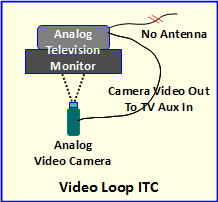 |
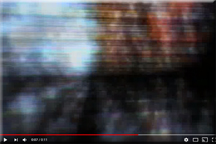 youtu.be/P2xXCAWRs4k |
The first example from Jean-Marc Bernad’s Facebook page is a grabbed video frame from a video-loop session. The right half of the picture is the original video frame. The left half includes an enlargement of the face you can see in the lower half of the original frame. The face appears to be that of a woman with curly hair. She is looking toward your right shoulder.
 |
 |
Just above her hair and a little to the right is a second, smaller face. It has been enlarged as the inset at the top-center of the original frame. I have enhanced it for better visibility in the adjacent picture at the right. You should see a round-faced boy facing toward your right shoulder, head slightly bent down as if he is looking over his right shoulder at your left elbow. He appears to be wearing a hat that covers his ears.
The point I want to make is that everything about Jean-Marc Bernad’s example is consistent with what we have come to expect for visual ITC. A common indicator of visual ITC is that every suitable area of the frame is typically taken by a face feature. Sometimes, a larger face will be made of smaller faces, as if the background noise consists of faces.
My speculation is that the face is representative of the person in our worldview. We are the channel through which instances of ITC are formed. Being unconsciously aware of other personalities around us, our mind naturally fills blank spaces with their psi signal. The face is not communication so much as it is our mind expressing how it senses the collective of personalities who are always with us.
To compare, the next video frame is one collected by Lisa and me. At the left is the original full video frame. The right is the same frame, but with a little of the background erased to make the faces easier to see. I see a young lady on the left of the frame who is facing toward the right. She also seems to have curly hair. Just below her chin and at the bottom of the frame appears to be a small dog’s head looking toward you. There appears to be a dog at the top-right and a rabbit bottom-right. Both are facing the girl.
 |
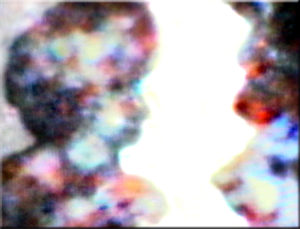 |
Next is another video-loop example from Jean-Marc Bernad’s Facebook page. The original is on the left. You should be able to make out a face-feature middle-top. That is enlarged and slightly enhanced on the right. You should see a young man’s face looking to your left shoulder. He seems to have a pleasant smile and may be saying something.
There is a secondary feature near the young man’s left ear, and a second partially obscuring his chin. Both may be small animals. If we were to apply the Class A, B and C system used for EVP, I would class the man as Class B and the animals as Class C.
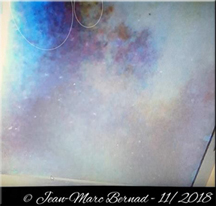 |
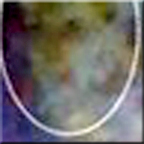 |
Next, is the video-loop frame in which I found my avatar. Look at the lower-left edge of the full video frame at the left. It is in the brighter area. An enlarged, slightly enhanced copy of it is in the right picture. I see a man, as if in a portrait, looking to my right shoulder. He has a full beard, receding hairline and is wearing a ruff around his neck. Ruff collars were popular in the 1500s. In our work, the color tends to be true so that it is reasonable to say the skin is correctly rendered relative to the beard color.
Look at the top-center of the original video frame and at the right of the bright region. A poorly formed face can be seen there. Looking closer at the entire frame, you should be able to see that wallpaper effect I think of as the face background so common in visual ITC.
 |
A Little About the Phenomenon
This is a good place to explain a few of the common characteristics we see in visual ITC. First, they are formed from available energy in the signal. That means they are limited by what is available. For instance, if only red light is available, they will be shades of red. If the light is too strong, the shading will go away, and you will see nothing.
The features are also limited by the resolution of the technology. A very low-resolution display or camera will be able to display much less detail. The detail may be there, but you will not be able to see it. The features are produced by applying physical principles. For instance, we think stochastic amplification is key to the effect of intended order on noise. The features should not exist, but since they do, we should not be surprised that they are not perfect photographs. In fact, it is common that the lower part of the face is obscured. Clearly, it is the eyes that we image in our mind.
The average person should be able to collect an example. I would suggest taking pictures of light reflecting from moving water. We have taught classes using water and the students had some success. As with every human endeavor, some are better at it than others, but I think one can develop the ability to some extent. I am not fond of the theory that some people have stations on the other side with people dedicated to helping them. Some visual ITC is spontaneous, but a good medium is more likely to call in a specific person to appear as an ITC feature.
The practitioner and interested observers are thought to be part of the communication circuit. Doubt tends to diminish clarity of communication. However, saying “I believe” is not good enough. It is your mostly unconscious mind that must believe. Habitually intending to understand and suspended judgment tends to open the channel.
More Examples
The next example is formed in light reflecting from moving water. It is an easy technique discussed in Begin Faces in Light Reflected from Water and ITC experiments using Light Reflected from Water. Simply put some water in a bowl so that the water appears dark. We use a colored CorningWare pot placed in a black pan. Shine a light over the water and agitate the water with your finger while taking snapshots of the moving water. Examine the snapshots for faces. Be sure to rotate the picture and occasionally step back to change perspective.
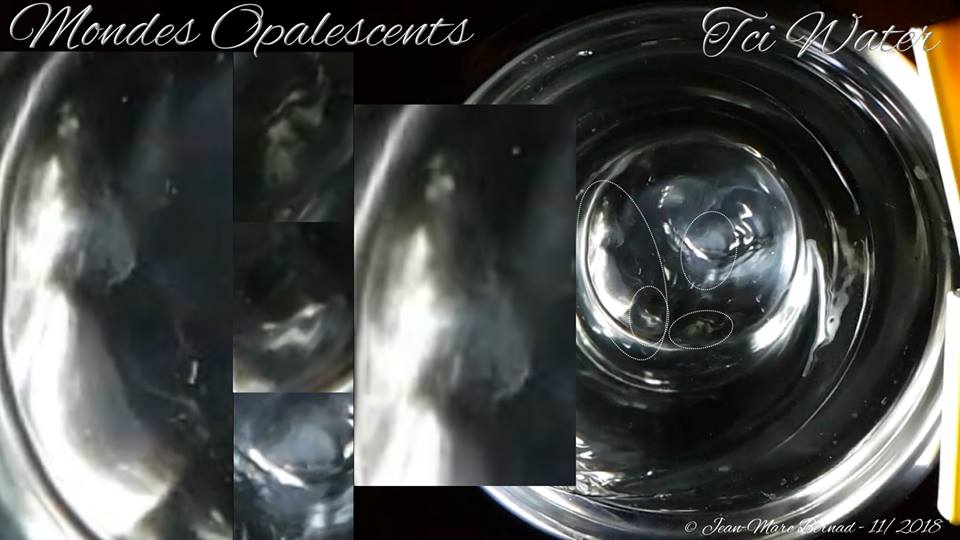
Jean-Marc Bernad’s example includes quite a few poorly formed features and a few that are clearly faces. He has inset a few of them at the left. Especially look at the area of brightness on the left side of the bottom of the bowl. He has enlarged that area in the middle of the picture.
The moving water technique tends to produce higher resolution images, but they are often distorted, as if smeared by the moving water. In the center inset of Jean-Marc’s moving water example, I see a standing man who is facing my right shoulder. He is wearing a white robe and appears to have his arms crossed in front of his chest. He has a very long dark beard. I can clearly see his right cheek, eye, forehead and nose.
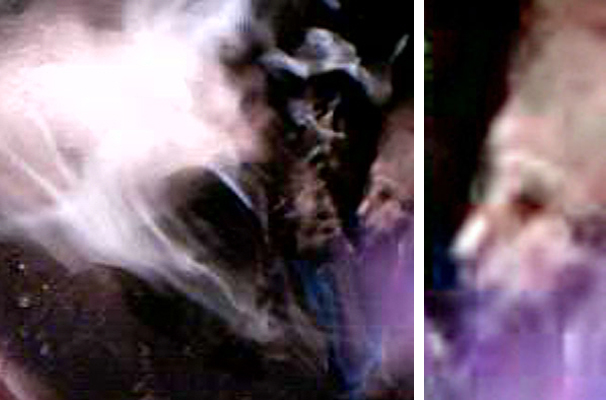
Our example I have included here was recorded during a class in the Cadbury Mansion at Cober Hill, England. Lisa and I taught a workshop for a Stewart Alexander conference You should see two faces. The primary feature is a man’s head facing to the left. He appears to be wearing a hat or crown. He has a very straight nose and long neck.
If you look closely, you will see a Class C face looking back at the man. They are very close together and about the same scale, as if in the same scene. You should be able to see that the man appears to be holding his left hand over his mouth. Again, the features have been collected by photographing light reflecting from moving water.
Full Disclosure
Some people do enhance their examples to make them easier to hear or see. I have enhanced examples, almost always by changing contrast and brightness. Sometimes small enhancement like that helps to make the features more easily seen.
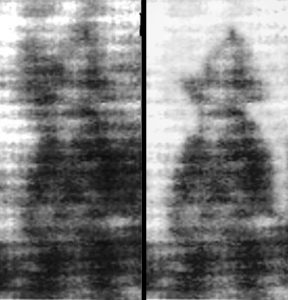 It is important to explain to witnesses how the example has been enhanced. When I say, “here is an enhanced version,” I am saying that the picture is the same as in its raw form, but intensity and contrast have been changed to clarify the feature. Perception of Visual ITC Images includes examples that show the before and after of this kind of enhancement.
It is important to explain to witnesses how the example has been enhanced. When I say, “here is an enhanced version,” I am saying that the picture is the same as in its raw form, but intensity and contrast have been changed to clarify the feature. Perception of Visual ITC Images includes examples that show the before and after of this kind of enhancement.
If I do something like remove the background, as I did in the example of the sitting man feature, it is important that I explain what was done. This is all about managing witness expectation so that they can tell what is thought to be paranormal and what is not.
As a witness, I cannot know what has been done to the original unless told by the practitioner. I notice that some practitioners seem to superimpose a photograph of the person over the apparently paranormal feature without explaining or showing the original. I have come to expect these phenomena to fall within a range of characteristics of clarity. I also try to error on the side of caution. If there is any question in my mind that the feature has been modified to better make the practitioner’s point, and without proper disclosure, I tend to ignore all the person’s examples.
Any technique that produces suitably chaotic noise is probably useful for ITC—visual and audio. Keith Clark’s iDigitalMedium is a good example in which faces are sometimes found in a streaming waveform. With that said, there are several techniques in common use that are so misleading and full of false positives that I recommend against their use. One is obscuring a physical person’s face with a cloth. Another is moving the camera while taking a picture of a normal object. The claimed transfiguration is usually just confused but otherwise normal optics.
I am writing this essay to explain that I agree with witnesses who express doubt. It is for the practitioner to be as clear as possible about what is being presented. However, in turn, it is for the witness to be informed about these phenomena or learn from the practitioner’s expertise to become informed.
If you are not an expert in this field (I consider myself knowledgeable but not an expert), the wisest approach to these phenomena is to practice suspended judgment. You need not make an accept or reject decision. If in doubt, mentally put the example in the “Wait for further information folder” of your memory and go on.
I cannot stress enough how important it is to be aware of how your mind unconsciously processes information before it is presented to conscious self. Important to this essay is that once a decision is made, your mental process for decisions is reluctant to change. In effect, you become vested in being wrong. See Conditional Free Will for an in-depth discussion of how we think.
In Conclusion
I have learned a great deal from others, either by working with them or by witnessing their work. We are a community. Working alone, we are doomed to forever repeat the same follies. It is only through mutual respect, shared discoveries and common purposes that we have hope of furthering our understanding of these phenomena and how they relate to our wellbeing.
Become informed about the nature of these phenomena before commenting about the validity of examples. The elephant-paranormal is so complex that even six blind men could not describe its nature. It takes the help of people who can see.
![]()
